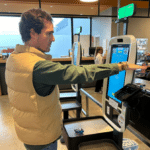The face of commerce: When your identity becomes your wallet

By Matt Marino, President of WinkPay, Wink
Traditional leather wallets have reason to sweat. Why carry a stack of plastic rectangles and half-punched loyalty cards when the one credential you can’t misplace – your own face (or palm) – now unlocks the same perks and pays the bill before you can say “Chip reader again?” The convergence of biometrics, loyalty, and payments isn’t futuristic vaporware; it’s already opening cash drawers at QSRs, hotels, and stadiums.
Consider the numbers. The Business Research Company predicts the biometric payments market will reach $46.6 billion next year, even before regulators settle the acronym soup in the fine print. Meanwhile, J.P. Morgan is piloting pay-by-face at Whataburger and has rolled out frictionless concessions throughout San Francisco’s Chase Center. And this isn’t just a Fortune-500 upgrade: the same off-the-shelf cameras and cloud APIs let a neighborhood boba shop add biometrics onto its POS, turning every order into a fast, frictionless, fraud-proof, loyalty-linked experience that keeps Mom-and-Pop retailers as competitive as the majors.
This is where loyalty programs stop being punch-card nostalgia and start acting like real-time identity engines. One biometric enrollment can link every latte, airline mile, and cash-back reward offer to a verified profile, minus the awkward “What’s your phone number again?” at checkout. The upside is hyper-personalization; the downside is a privacy hangover. With 71% of Americans worried about corporate data use (Pew Research), brands must prove that “know your customer” never mutates into “own your customer” by following three visible rules – store only encrypted templates, make the experience optional, and give consumers one-tap control over their data – exactly the trust playbook merchants keep asking Wink to deliver.
Momentum, though, is unmistakable. Goode Intelligence forecasts 3.5 billion people – nearly half the planet – will join the “pay-by-me” club by 2030, driving $11.3 billion in revenue for biometric suppliers. On mobile alone, Juniper Research expects biometric transactions to smash the $3 trillion mark in 2025. Plastic isn’t dying of old age; it’s getting out-innovated.
What’s next? Picture a checkout flow where your face triggers an instant discount because the POS knows you’re four visits shy of gold status, verifies your age for that Pinot, and closes the tab. No taps, no codes, near-zero fraud liability. If that sounds dystopian, remember: every disruptive tech begins as a privacy scare, matures into a utility, and ends up as table stakes. Smart money – and smarter merchants – will skate to where this puck is headed, not where the card reader sits today.
Physical cards are on their farewell tour. For retailers, banks, and fintech startups, the encore belongs to biometric payments that make loyalty invisible and fraud obsolete. The only question is whether you want to headline the show, or queue for tickets someone else buys with a smile.
About the author
Matt Marino leads the Wink’s open payments ecosystem – an innovative platform that harnesses biometric authentication to simplify transactions, eliminate fraud, and enrich customer experiences. Drawing on more than 20 years of FinTech experience, Matt has built and scaled go-to-market teams at Visa, WePay, JPMorgan Chase, Global Payments, and multiple venture-backed startups. He is a graduate of Santa Clara University and Harvard Business School.
Article Topics
biometric payments | biometrics | digital payments | digital wallets | Wink







Comments